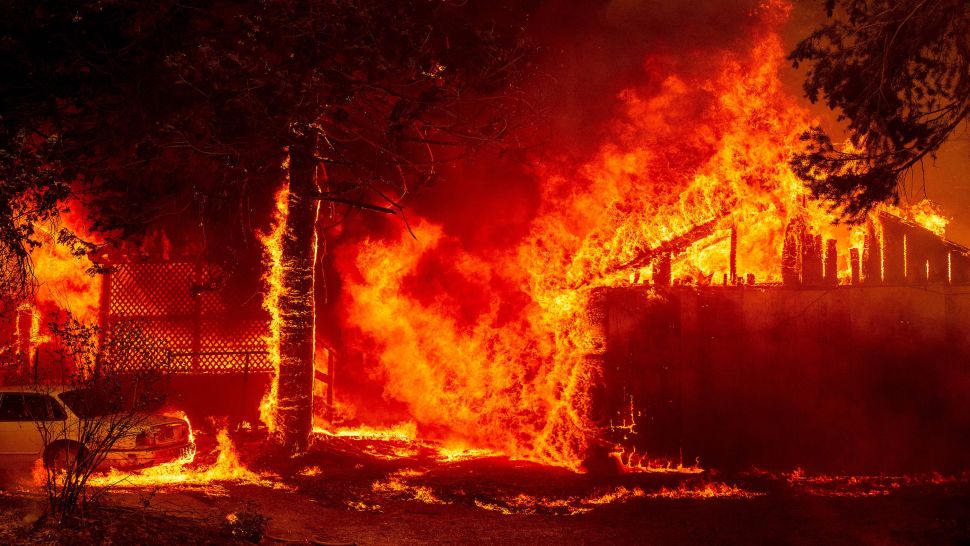Burning through parched fuel like matchsticks, the Dixie Fire in Northern California has mushroomed in size this week to become the largest single wildfire in the state’s history, according to news reports.
The fire, which covers large parts of Butte and Plumas Counties, ignited around midnight on July 14 and has been raging ever since, fostered by the low humidity, high winds and already dried-up foliage, The Washington Post reported.
Dixie decimated the small Plumas County town of Greenville on Wednesday, reducing parts of the downtown to piles of rubble and leveling more than 100 homes in the area, USA Today reported.
Overnight Thursday (Aug. 5), the fire grew by about 70,000 acres (28,327 hectares) and as of Saturday morning, it covers an area of 446,723 acres (180,782 hectares), or more than half the size of Rhode Island. Currently, 21% of the fire is contained, according to the California Department of Forestry and Fire Protection (CalFire). “Dry fuels are creating serious resistance to control,” CalFire said.
To date, the Dixie wildfire has destroyed 184 structures, damaging another 11, with no injuries or fatalities reported. CalFire says about 13,871 structures are threatened by the fire.
The cause of the fire is still under investigation, according to CalFire. But Pacific Gas & Electric, the utility company in the area, said its equipment could be to blame for starting the blaze, the Post reported.
The fire has burned through 153,336 acres (about 62,000 hectares) in Butte County in 2018, destroying 18,804 structures and resulting in 85 deaths, CalFire reported. That fire was the most destructive, deadliest wildfire in the state’s history.
And as the Dixie Fire continues to ravage hundreds of thousands of acres in Northern California, a federal judge has now ordered Pacific Gas & Electric to explain the utility company’s role in starting what has become the largest wildfire burning in the United States.
The cause of the blaze remains under investigation, but U.S. District Judge William Alsup asked PG&E in an order issued late Friday to give information regarding the tree that fell on the utility company’s power line at the origin of the Dixie Fire. PG&E has said its equipment may have been responsible for starting both the Dixie Fire and the much smaller Fly Fire, which later merged with the Dixie Fire.
Alsup — who oversees PG&E’s criminal probation for felony convictions stemming from the deadly 2010 San Bruno gas pipeline explosion — also required that PG&E give details about the equipment and vegetation in the area where the fires started. The San Francisco judge said the company would have until Aug. 16 to respond.
“PG&E’s responses will not be deemed as an admission by PG&E that it caused any fire, but they will serve as a starting point for discussion,” wrote Alsup, of the Northern District of California.
A PG&E spokesperson told The Washington Post on Saturday that the utility was aware of the court’s orders, saying PG&E “will respond by the deadline.”
California’s Dixie Fire has burned for more than three weeks, scorching at least 440,000 acres as of Aug. 7. (Reuters)
Seven of the eight people who were listed as unaccounted for on Friday evening in towns devastated by the third-largest wildfire in state history have been safely located, an official with the Plumas County Sheriff’s Office told The Post. Most of the people who were unaccounted for were from Greenville, Calif., a sparsely populated mountain town that’s been destroyed by the Dixie Fire. One person remains missing as of Saturday.
At nearly 447,000 acres burned in Butte and Plumas counties, the Dixie Fire is on track to potentially surpass the massive 2018 Mendocino Complex Fire in size in the days ahead. Though fire officials have expressed hope that rising humidity levels would help them counter the blaze, so far the hot, arid and windy conditions have turned the Dixie Fire into what one expert dubbed as “kind of the perfect storm.”
“If it gets in that range [of the Mendocino fire],it’ll be by far the largest fire in the Sierra Nevada history and also the Southern Cascades,” Scott Stephens, a professor of fire sciences at the University of California at Berkeley, told The Post.
The reported containment area of the Dixie Fire dropped to 21 percent on Friday night; officials announced earlier in the day that containment was at 35 percent. Rick Carhart, a spokesperson with Cal Fire, said better mapping clarified the extent of the containment.
“Once we got in there and were able to do some better mapping, we found … there is a whole lot more uncontained line out there,” Carhart told the San Francisco Chronicle.
In Greenville, Calif., the historic small town of about 1,100 residents was left in ashes from the Dixie Fire. The U.S. Fire Service estimated that only about a quarter of the town’s structures had been saved. In a video of the devastation late Friday, journalist Maranie R. Staab observed of Greenville: “There is nothing left.”
There is nothing left. #dixiefire #greenville #wildfire pic.twitter.com/PtBLaLezbD
— Maranie R. Staab (@MaranieRae) August 7, 2021
Some of the thousands of evacuees from across Northern California fled to Susanville, located less than 40 miles from the Nevada border. More than 7,000 people in surrounding Plumas County had been evacuated by Friday, and officials added new evacuation orders for adjacent Lassen County.
Rob Poindexter said he evacuated from his home in Westwood, Calif., about 25 miles west, on Thursday afternoon. Poindexter, 68, didn’t initially think hewould be evacuated, but said that changed after someone knocked on his door at around 2 p.m. Thursday, telling him to leave the area. He grabbed some clothes, a tent, a sleeping bag and some important documents, and began driving away from the small town where he’s lived on and off for the past 42 years.
“I didn’t feel like wasting time getting out,” he said to The Post, recalling how the sky was pitch-black when he left town. “It looked apocalyptic.”
Inside Greenville, Calif., the town ‘lost’ to the Dixie Fire
As several wildfires blaze throughout the country, federal authorities are deciding how to distribute firefighting resources. The Dixie Fire remains the top priority in both California and the country: About 25 percent of available resources have been dedicated to the blaze and nearly 5,000 firefighters are battling it. But there are more than 100 active wildfires, with new ones erupting in recent days in Alaska, Oregon, Idaho, Washington state, Montana and Wyoming.
The ongoing threat from multiple blazes means firefighters have to make difficult decisions on how to divvy up already-stretched resources, said Riva Duncan, a retired fire staff officer for the U.S. Forest Service.
“They’re trying to send as many resources as they can to support prioritized fires without just pulling everything off other fires that are maybe not as threatening,” she said. “But certainly we can’t just pull everybody off every fire, so it’s a balance. It’s a difficult strategic decision.”
Yet that balancing act also has shortcomings. Remote and smaller fires often take longer to put out due to the lack of available personnel and equipment, Duncan said, causing firefighters to “accept riskier assignments because they feel like they need to cover it.”
Duncan, who also serves as secretary-treasurer for the Grassroots Wildland Firefighters, a group advocating for the well-being of federal wildland fire personnel, said the results have a “snowball effect” on federal firefighters. Some see their mental health suffer as a result, while others leave for state agencies with more lucrative salaries. And some firefighters leave the field altogether, she said.
“With those towns burning and structures burning, that’s really hard on firefighters,” Duncan said. “A lot of them are part of those communities, and to feel like they failed watching homes burn also weighs mentally on what these wildland firefighters are doing.”
The Dixie Fire’s changing pace has baffled experts, Stephens said. Before torching Greenville, the inferno seemed to be holding off. Then it erupted and continued moving north — leaving incinerated communities in its wake.
Yet its behavior is not necessarily new, Stephens said, noting that it underscores a years-long trend of conditions being ripe for burning.
“With the two-year drought here, these are maybe the lowest precipitation levels in California since 1975 or 1976,” he said. “It means our fuels are incredibly dry. So where we are right now is really about six weeks earlier into our summer.”
While climate change has exacerbated such conditions, the fire science professor said lackluster upkeep of the area’s vegetation has been the main factor contributing to a dire and potentially longer wildfire season that’s been led by the historic Dixie Fire.
“I’m still hopeful that we can change the trajectory of these fires,” he said, “but it’s going to take decisive action.”





